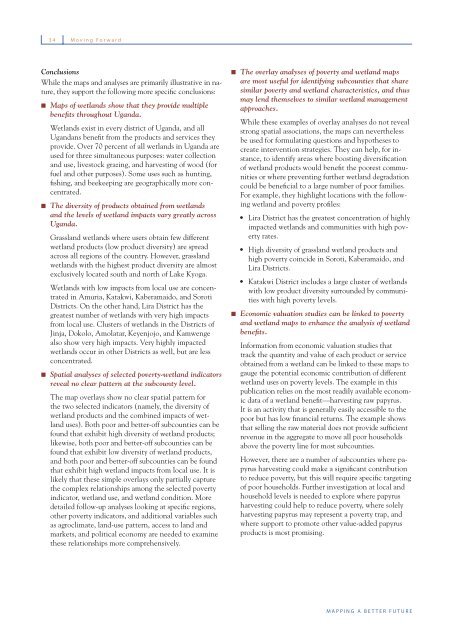Mapping a Better Future - World Resources Institute
Mapping a Better Future - World Resources Institute
Mapping a Better Future - World Resources Institute
Create successful ePaper yourself
Turn your PDF publications into a flip-book with our unique Google optimized e-Paper software.
34 Moving Forward<br />
Conclusions<br />
While the maps and analyses are primarily illustrative in nature,<br />
they support the following more specific conclusions:<br />
Maps of wetlands show that they provide multiple<br />
benefits throughout Uganda.<br />
Wetlands exist in every district of Uganda, and all<br />
Ugandans benefi t from the products and services they<br />
provide. Over 70 percent of all wetlands in Uganda are<br />
used for three simultaneous purposes: water collection<br />
and use, livestock grazing, and harvesting of wood (for<br />
fuel and other purposes). Some uses such as hunting,<br />
fi shing, and beekeeping are geographically more concentrated.<br />
The diversity of products obtained from wetlands<br />
and the levels of wetland impacts vary greatly across<br />
Uganda.<br />
Grassland wetlands where users obtain few different<br />
wetland products (low product diversity) are spread<br />
across all regions of the country. However, grassland<br />
wetlands with the highest product diversity are almost<br />
exclusively located south and north of Lake Kyoga.<br />
Wetlands with low impacts from local use are concentrated<br />
in Amuria, Katakwi, Kaberamaido, and Soroti<br />
Districts. On the other hand, Lira District has the<br />
greatest number of wetlands with very high impacts<br />
from local use. Clusters of wetlands in the Districts of<br />
Jinja, Dokolo, Amolatar, Keyenjojo, and Kamwenge<br />
also show very high impacts. Very highly impacted<br />
wetlands occur in other Districts as well, but are less<br />
concentrated.<br />
Spatial analyses of selected poverty-wetland indicators<br />
reveal no clear pattern at the subcounty level.<br />
The map overlays show no clear spatial pattern for<br />
the two selected indicators (namely, the diversity of<br />
wetland products and the combined impacts of wetland<br />
uses). Both poor and better-off subcounties can be<br />
found that exhibit high diversity of wetland products;<br />
likewise, both poor and better-off subcounties can be<br />
found that exhibit low diversity of wetland products,<br />
and both poor and better-off subcounties can be found<br />
that exhibit high wetland impacts from local use. It is<br />
likely that these simple overlays only partially capture<br />
the complex relationships among the selected poverty<br />
indicator, wetland use, and wetland condition. More<br />
detailed follow-up analyses looking at specifi c regions,<br />
other poverty indicators, and additional variables such<br />
as agroclimate, land-use pattern, access to land and<br />
markets, and political economy are needed to examine<br />
these relationships more comprehensively.<br />
The overlay analyses of poverty and wetland maps<br />
are most useful for identifying subcounties that share<br />
similar poverty and wetland characteristics, and thus<br />
may lend themselves to similar wetland management<br />
approaches.<br />
While these examples of overlay analyses do not reveal<br />
strong spatial associations, the maps can nevertheless<br />
be used for formulating questions and hypotheses to<br />
create intervention strategies. They can help, for instance,<br />
to identify areas where boosting diversifi cation<br />
of wetland products would benefi t the poorest communities<br />
or where preventing further wetland degradation<br />
could be benefi cial to a large number of poor families.<br />
For example, they highlight locations with the following<br />
wetland and poverty profi les:<br />
• Lira District has the greatest concentration of highly<br />
impacted wetlands and communities with high poverty<br />
rates.<br />
• High diversity of grassland wetland products and<br />
high poverty coincide in Soroti, Kaberamaido, and<br />
Lira Districts.<br />
• Katakwi District includes a large cluster of wetlands<br />
with low product diversity surrounded by communities<br />
with high poverty levels.<br />
Economic valuation studies can be linked to poverty<br />
and wetland maps to enhance the analysis of wetland<br />
benefits.<br />
Information from economic valuation studies that<br />
track the quantity and value of each product or service<br />
obtained from a wetland can be linked to these maps to<br />
gauge the potential economic contribution of different<br />
wetland uses on poverty levels. The example in this<br />
publication relies on the most readily available economic<br />
data of a wetland benefit—harvesting raw papyrus.<br />
It is an activity that is generally easily accessible to the<br />
poor but has low financial returns. The example shows<br />
that selling the raw material does not provide sufficient<br />
revenue in the aggregate to move all poor households<br />
above the poverty line for most subcounties.<br />
However, there are a number of subcounties where papyrus<br />
harvesting could make a signifi cant contribution<br />
to reduce poverty, but this will require specifi c targeting<br />
of poor households. Further investigation at local and<br />
household levels is needed to explore where papyrus<br />
harvesting could help to reduce poverty, where solely<br />
harvesting papyrus may represent a poverty trap, and<br />
where support to promote other value-added papyrus<br />
products is most promising.<br />
MAPPING A BETTER FUTURE

















